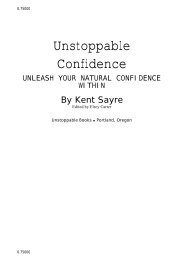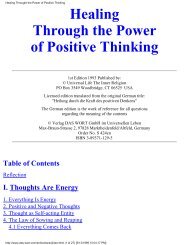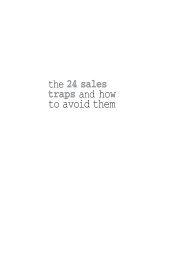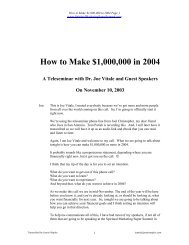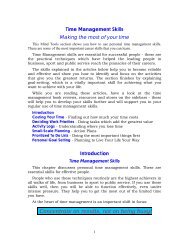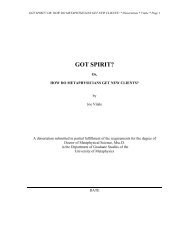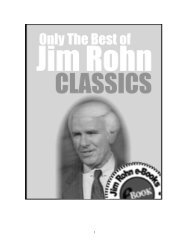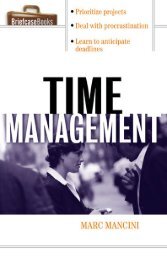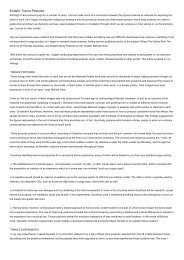Executive Coaching - A Guide For The HR Professional.pdf
Executive Coaching - A Guide For The HR Professional.pdf
Executive Coaching - A Guide For The HR Professional.pdf
You also want an ePaper? Increase the reach of your titles
YUMPU automatically turns print PDFs into web optimized ePapers that Google loves.
220 Index<br />
............<br />
workplace, 125; education factor in,<br />
30; experience as factor in, 31–32;<br />
of internal coaches, 35–40; for multicultural<br />
coaching, 120–121; references<br />
used in, 28–29; size of firms and, 29;<br />
skills and competencies factors of,<br />
32–33; things to avoid in coach,<br />
34–35; working with client in, 33–34<br />
Coach-client relationship: as business<br />
relationship, 82–83; dealing with<br />
normal anxieties, 78–80; establishing<br />
ground rules and trust in, 80–81; good<br />
chemistry and, 29, 42; reducing<br />
likelihood of “drift” in, 96; structuring<br />
the, 32–33; time commitments of, 83;<br />
trust/confidentiality as part of,<br />
43–45. See also Clients<br />
“Coachable moments,” 84–87<br />
Coaches: actions not performed/<br />
expected from, 100–101; client rejection<br />
of, 25; coaching assignment role<br />
of, 95–103; communicating with<br />
organizational sponsors, 96–97; communication<br />
between <strong>HR</strong> professional<br />
and, 65–66; continual feedback provided<br />
to <strong>HR</strong> professional by, 74–75;<br />
education and certification of, 30–31;<br />
evaluating impact of coaching,<br />
99–100; external, 39–40; internal,<br />
35–40; organization use of, 25; orientation<br />
to organization provided for,<br />
69–70; setting boundaries for coaching<br />
assignment, 97–99; things to<br />
avoid in, 34–35<br />
<strong>Coaching</strong>: appropriate times for, 17–23;<br />
connecting business objectives to, 72;<br />
consulting vs., 14; definitions of,<br />
12–14; definitions of terms related to,<br />
14–15; driving forces behind organizational<br />
change and, 10–12, 11t; a<br />
short history of, 9–10; structuring the<br />
process, 95–96; when not appropriate,<br />
23–25; when to discontinue,<br />
101–102<br />
<strong>Coaching</strong> assignments: assimilation,<br />
107–110; authorized of, 90–91; boss’s<br />
role in, 89–94; client’s role in, 77–87;<br />
coach’s role in, 95–103; contracting,<br />
13, 42–45, 58–59, 72; in diverse<br />
workplace, 123–126; executive<br />
development programs facilitated by,<br />
112–115; <strong>HR</strong> professional’s role in,<br />
71–76; multi-cultural issues of,<br />
117–126; spouse, 118; when to<br />
discontinue, 101–102<br />
<strong>Coaching</strong> assignments boundaries:<br />
professional limits, 98–99; scope<br />
creep, 98; time stretch, 97–98<br />
<strong>Coaching</strong> competencies, 32–33<br />
<strong>Coaching</strong> electronically: assessments,<br />
60; cautions regarding, 60; use of<br />
emails in, 59–60; increasing trend<br />
toward, 59<br />
<strong>Coaching</strong> situations: appropriate,<br />
17–23; categorizing, 13–14; in<br />
conjunction with formal succession<br />
planning, 20; contributions to learning,<br />
21–23; to develop leadership<br />
skills, 20; to improve performance,<br />
19; to improve soft skills, 19–20;<br />
opportunities for, 17–19<br />
<strong>Coaching</strong> steps: 1: contracting, 42–45;<br />
2: initial goal setting, 45–46; 3:<br />
assessment, 46–52; 4: implementation<br />
and action planning, 52–55; 5:<br />
evaluation, 55–58; listed, 41<br />
Communication: between coach and<br />
organizational sponsors, 96–97;<br />
confidentiality as blocking full, 66;<br />
email, 59–60<br />
Confidentiality: ethical standards<br />
and best practice of, 44–45; full<br />
communication blocked by, 66;<br />
information sharing and, 44;<br />
internal coaches and, 38; mutual<br />
trust and, 43<br />
Consulting, 14<br />
Contracting: benefits of good, 58–59;<br />
confidentiality issues during, 43–45;<br />
executive development programs,<br />
114; formally, 13; good chemistry<br />
and, 42; <strong>HR</strong> professional’s role in,<br />
72; points addressed in, 42–43<br />
Corporate Leadership Council, 32<br />
Credibility issues, 37<br />
Cross-cultural coach, 120–121<br />
Cross-cultural coaching methods:<br />
formal instruction, 120;<br />
programmed instruction,<br />
120; simulations, 119<br />
Customer satisfaction surveys,<br />
48, 57



